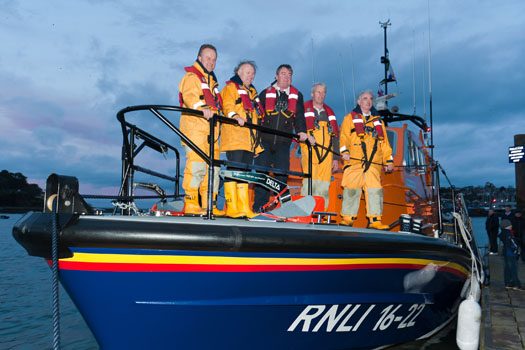#LIFEBOAT – Baltimore in West Cork welcomes its new lifeboat today when the RNLI delivers a new €3 million Tamar to the town. The boat named Alan Massey is the latest in life saving technology and it has been making a splash along the south coast over the past few days as it nears its new home.
Baltimore lifeboat shot to international prominence last August when it carried out the successful rescue of the Rambler 100 crew off the Fastnet rock. Its skipper Kieran Cotter won a special Afloat Sailor of the Month award for the rescue.

At full speed near Cork harbour. Photo: Bob Bateman
Baltimore's new Tamar is only the second such type of vessel operating in Ireland. The first was welcomed by President Mary MacAleese into Kilmore Quay last June.
The vessel RNLI 16-22 arrived in Kilmore Quay on Tuesday night and carried out exercises off Ballycotton arriving in Cork Harbour yesterday evening. The brand new boat was escorted into harbour by Crosshaven ILB lifeboat Miss Betty. Also there was RNLI Governor Peter Crowley's Sparetime (P Crowley) and other craft from Royal Cork Yacht Club.
She berthed overnight at Royal Cork and is expected in Baltimore harbour later today.

The Crosshaven ILB alongside the new Tamar boat. Photo: Bob Bateman
The Tamar will replace the existing Tyne lifeboat Hilda Jarrett, which has served the station since 1988. The new lifeboat is expected to arrive into the harbour at 2.15pm after leaving RNLI Headquarters in Poole late last week and has members of Baltimore volunteer lifeboat crew onboard including well known Baltimore RNLI Coxswain Keiron Cotter.
The new lifeboat, which is named Alan Massey (ON 1302) was largely funded through a legacy from Mrs Dorothy May Massey from Watford in England, and has been named in memory of her late brother Alan.

Alongside last night in Crosshaven. Photo: Bob Bateman
The new Tamar class lifeboat is 16.3 metres in length with a maximum speed of 25 knots compared to the 14.3 metres of Baltimore RNLI's current Tyne class lifeboat which has a maximum speed of 18 knots. The lifeboat is self-righting and is fitted with an integrated electronics systems and information management system, which allows the lifeboat crew to monitor, operate and control many of the boats systems from shock mitigating seats.
The Tamar also carries a Y boat (an inflatable daughter boat) which is housed under the aft deck and deployed from a hinged door in the transom. The lifeboat has room for 44 survivors.
The new Tamar lifeboat is not expected to be put on service until March and the next month will see all volunteer lifeboat crew perfect their training onboard the new vessel. The Hilda Jarrett lifeboat will then be put into the relief fleet to be used as needed.
All are welcome to come and see the Alan Massey Tamar lifeboat arriving into the harbour on Wednesday afternoon. Local schoolchildren, RNLI lifeboat crews and fundraisers past and present along with local residents are expected to line the harbour.
































































